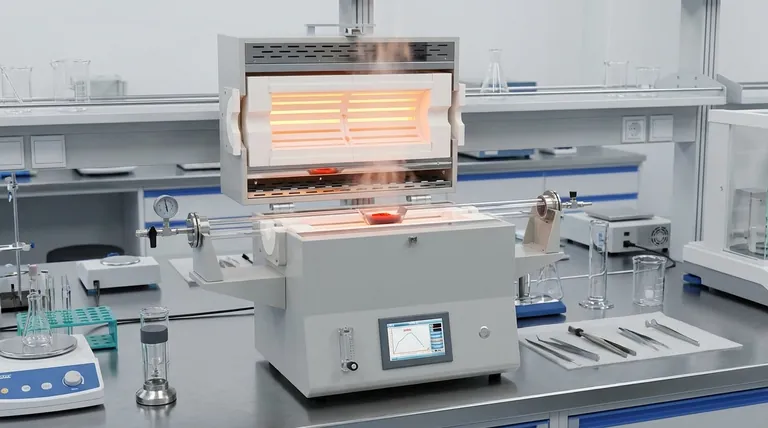At its core, a heating element works by converting electrical energy into heat through the principle of resistance. When an electric current is forced through a material that resists its flow, the resulting friction at the atomic level generates thermal energy. This fundamental process, known as Joule heating, is the mechanism that allows these components to produce heat efficiently and controllably.
Understanding a heating element goes beyond the basic principle of electrical resistance. Its true performance is defined by how its design and material composition work together to efficiently transfer that heat—either directly through radiation or indirectly via an intermediary material.

How Heat is Delivered: Two Core Designs
The way a heating element is constructed dictates how it transfers thermal energy to a target process or environment. The two primary methods are direct and indirect radiation, each with distinct characteristics.
Direct Radiation: Quartz Heaters
In a quartz infrared heater, the coiled resistance wire is housed within or wrapped around a quartz tube.
Because quartz is highly transparent to infrared energy, the heat generated by the element passes directly through the tube to the target. This results in the emission of short-to-medium wavelength infrared energy.
Indirect Radiation & Convection: Ceramic Heaters
With ceramic heaters, the coiled wire element is fully embedded within a ceramic body.
The element first heats the ceramic, which absorbs the energy. The ceramic itself then becomes the heat source, re-radiating the energy to the process.
This re-radiated energy is primarily longer-wavelength infrared. The large, hot surface of the ceramic also contributes to heating through natural convection.
Understanding the Trade-offs
The effectiveness and suitability of a heating element depend entirely on its material composition and the engineering required to support its operation.
Material Determines Temperature Range
The choice of resistance material directly limits the element's maximum operating temperature. This is a critical factor for any application.
For example, standard resistance wire is generally suitable for temperatures in the 1000-1200°C range. For higher temperatures up to 1300°C, a material like silicon carbide is required.
The Cost of Higher Temperatures
As a rule, materials capable of withstanding higher temperatures are more expensive. The selection must balance the required thermal performance against the project's budget.
Managing High-Power Connections
Delivering sufficient current to a high-power heating element creates its own thermal challenges at the connection points.
To prevent overheating and failure, these systems often use a water-cooled feed-through. This specialized, sealed connection allows electrical current to pass through while a non-conductive coolant dissipates waste heat.
Making the Right Choice for Your Goal
Your application's specific requirements will determine the best heating element design and material.
- If your primary focus is rapid, direct heating: A quartz heater is the ideal choice, as its direct radiation allows for fast energy transfer to the target.
- If your primary focus is stable, uniform area heating: A ceramic heater provides broad, even heat through re-radiation and adds the benefit of convective heating.
- If your primary focus is reaching very high temperatures: The choice is dictated by the element's material, requiring you to match a substance like silicon carbide to your specific temperature needs.
By understanding the interplay between material, design, and heat transfer, you can select and operate the correct heating element with precision and confidence.
Summary Table:
| Feature | Quartz Heater | Ceramic Heater | High-Temp Material (e.g., SiC) |
|---|---|---|---|
| Heat Transfer Method | Direct Radiation | Indirect Radiation & Convection | Radiation (material dependent) |
| IR Wavelength | Short-to-Medium | Long | Varies |
| Typical Max Temp | ~1000-1200°C | ~1000-1200°C | Up to 1300°C+ |
| Ideal For | Rapid, direct heating | Stable, uniform area heating | Very high-temperature applications |
Need precise thermal control for your laboratory processes?
At KINTEK, we specialize in high-performance lab equipment with heating elements engineered for reliability, efficiency, and exact temperature requirements. Whether you need the rapid response of a quartz heater or the uniform heat of a ceramic element for your furnace or oven, our experts can help you select the perfect solution.
Contact KINTEK today to discuss your application and ensure optimal performance for your lab's unique needs.
Visual Guide

Related Products
- 1400℃ Laboratory Quartz Tube Furnace with Alumina Tube Tubular Furnace
- Vertical Laboratory Quartz Tube Furnace Tubular Furnace
- 1700℃ Laboratory Quartz Tube Furnace with Alumina Tube Tubular Furnace
- 1400℃ Controlled Atmosphere Furnace with Nitrogen and Inert Atmosphere
- 1700℃ Controlled Atmosphere Furnace Nitrogen Inert Atmosphere Furnace
People Also Ask
- What is a tube furnace used for? Achieve Precise, Controlled Thermal Processing
- What is a tubular furnace used for? Precision Heating for Material Synthesis & Analysis
- What materials are used for the tubes in tube furnaces? A Guide to Selecting the Right Tube for Your Process
- What is the high temperature of a tube furnace? Unlock the Right Model for Your Application
- What are the advantages of a tube furnace? Achieve Superior Temperature Uniformity and Control



















